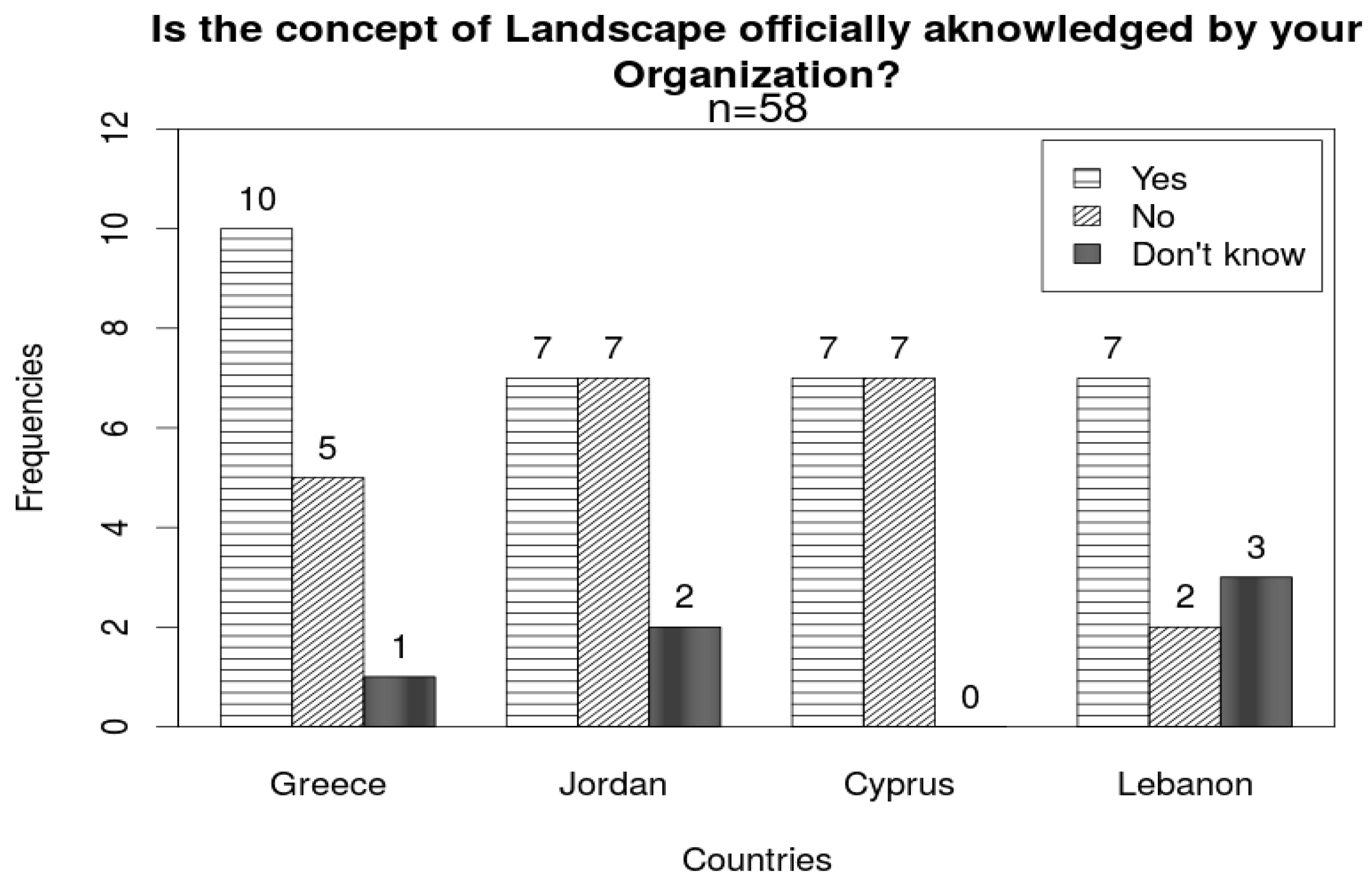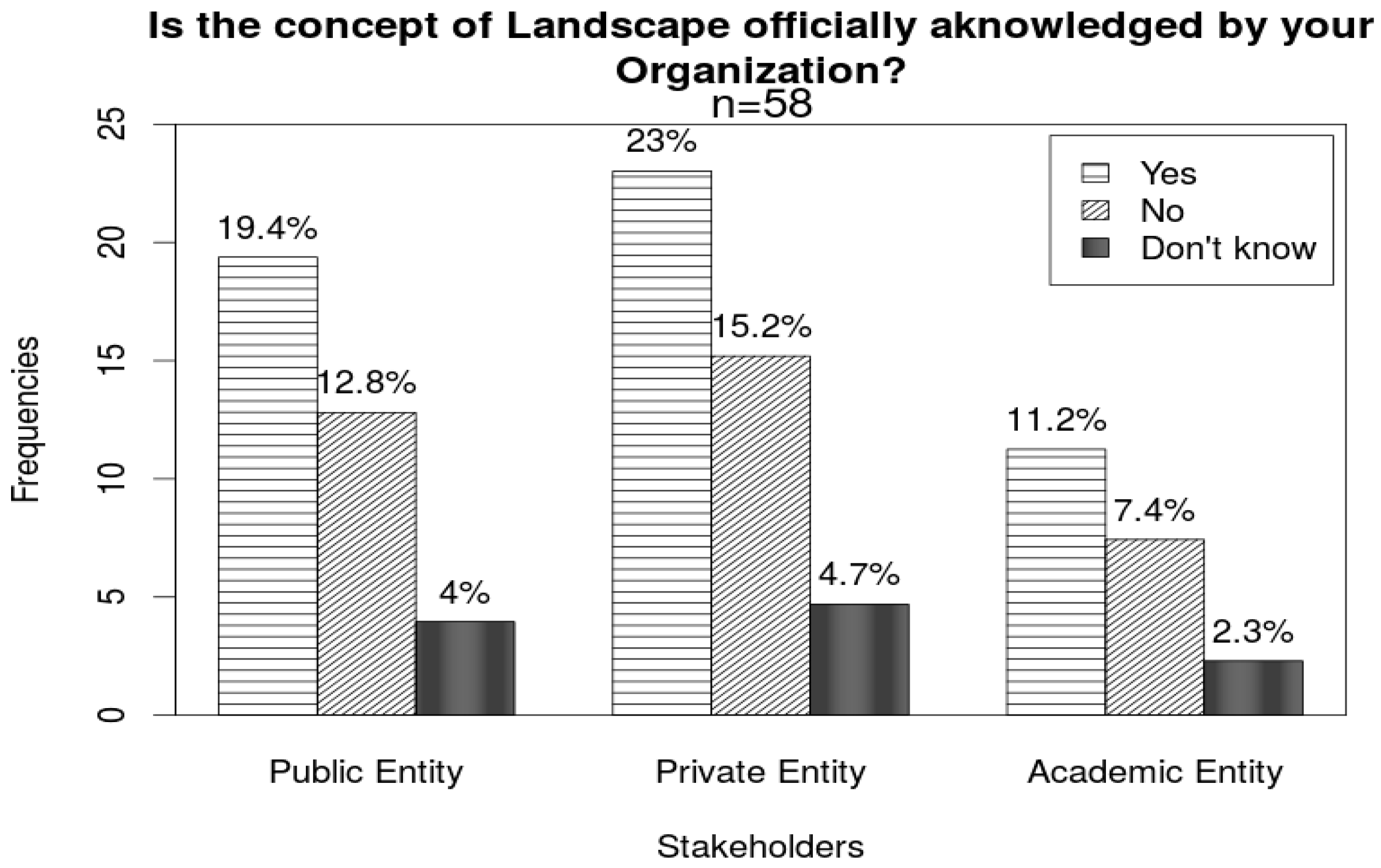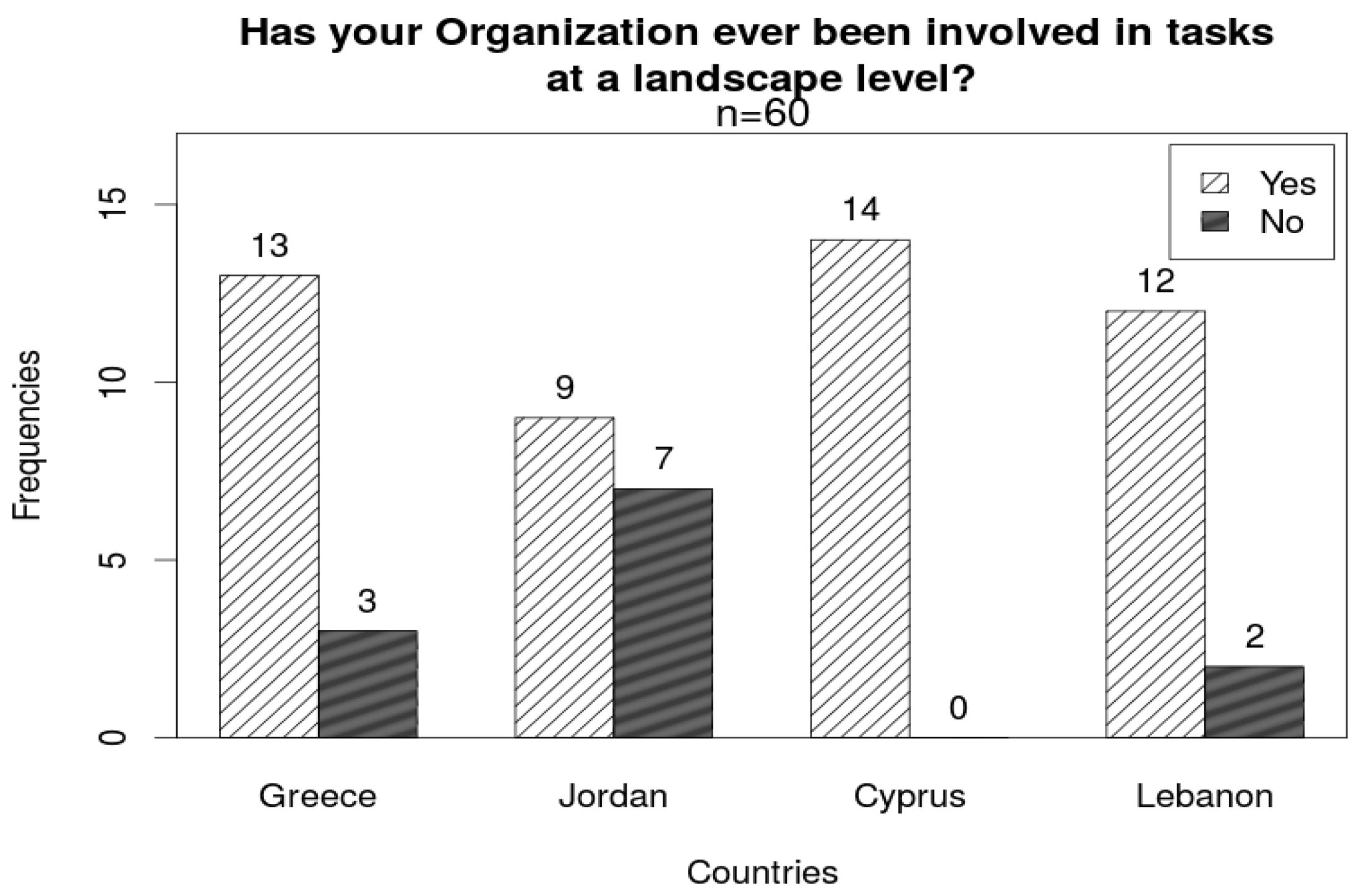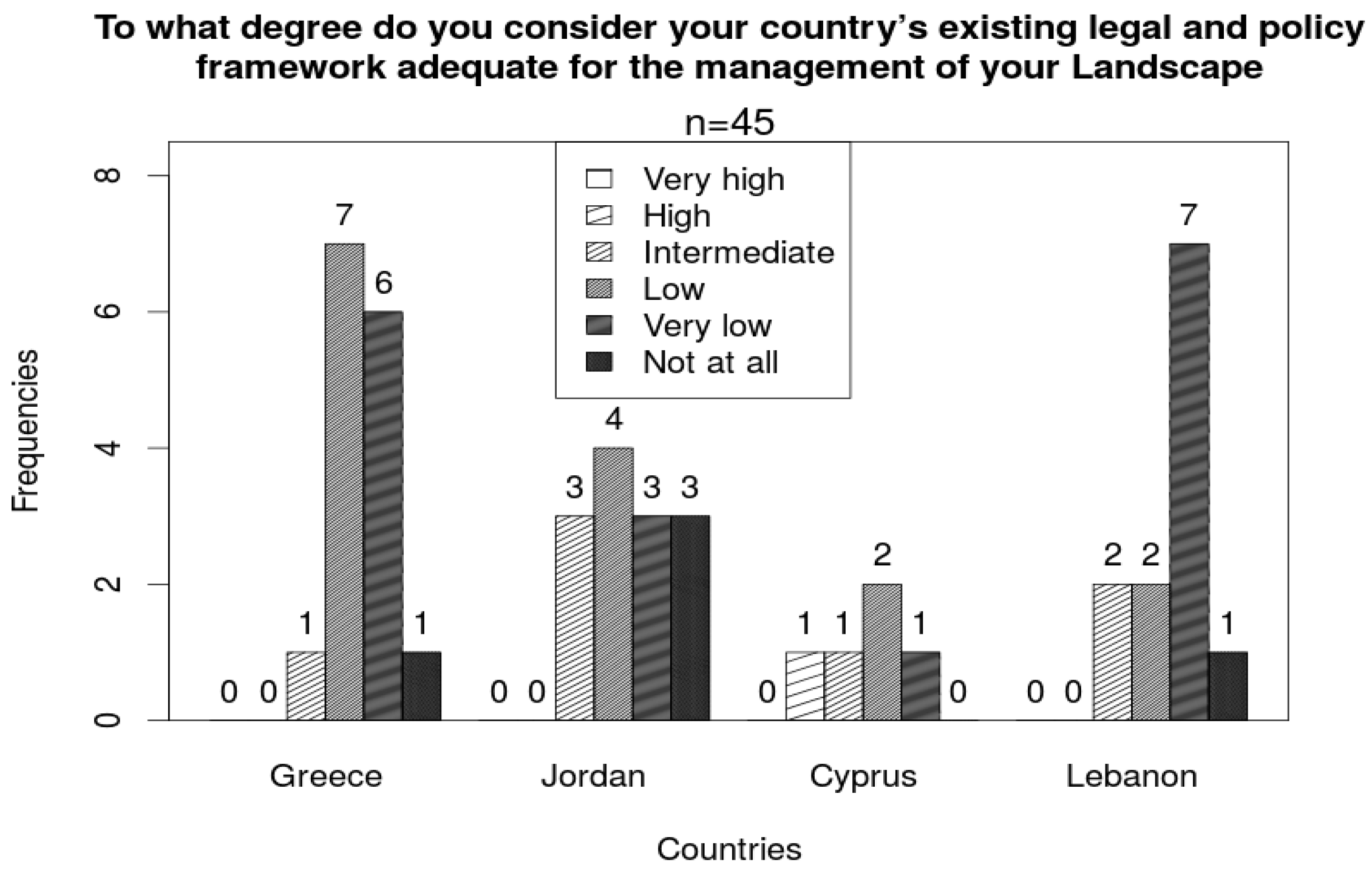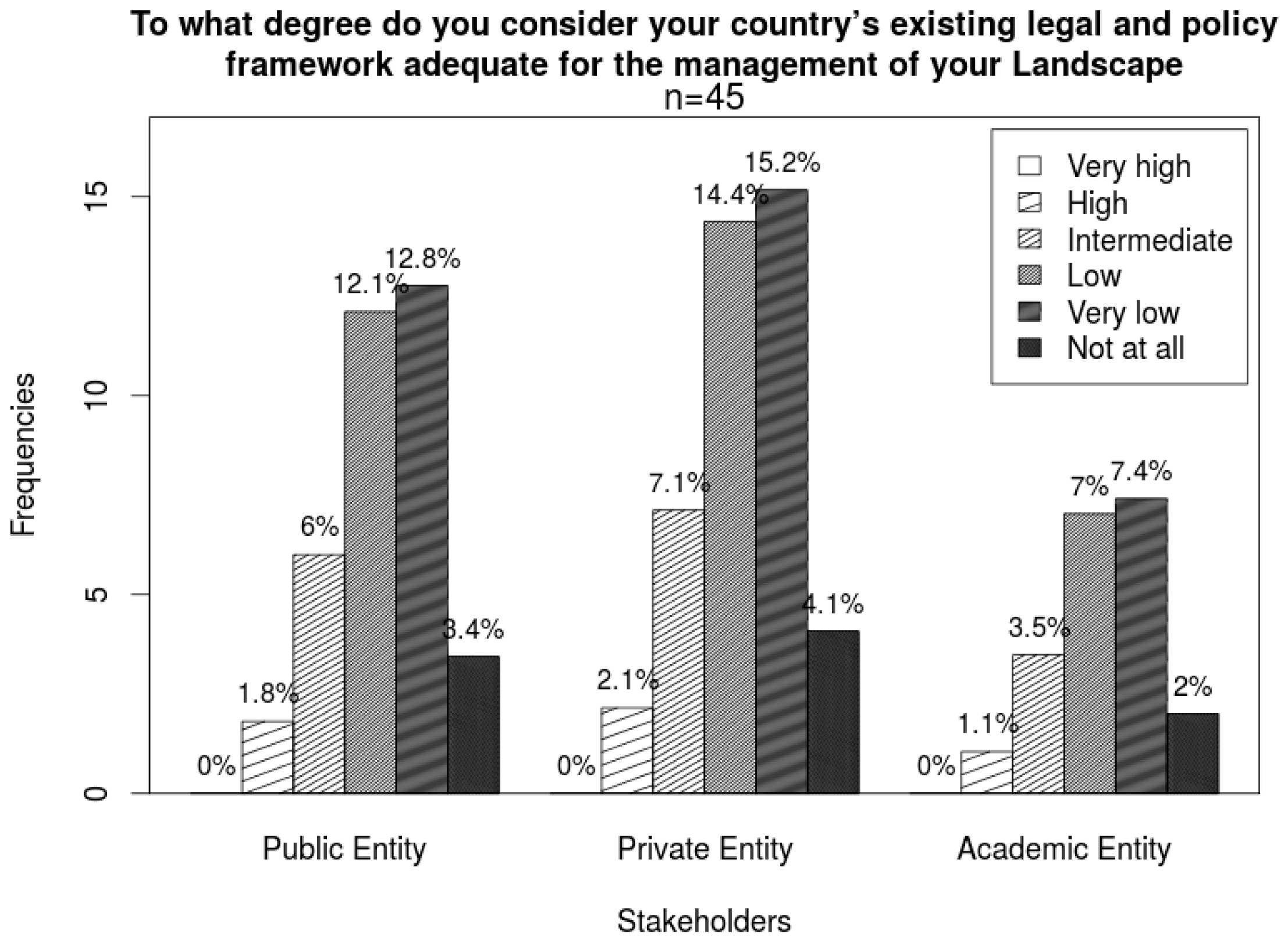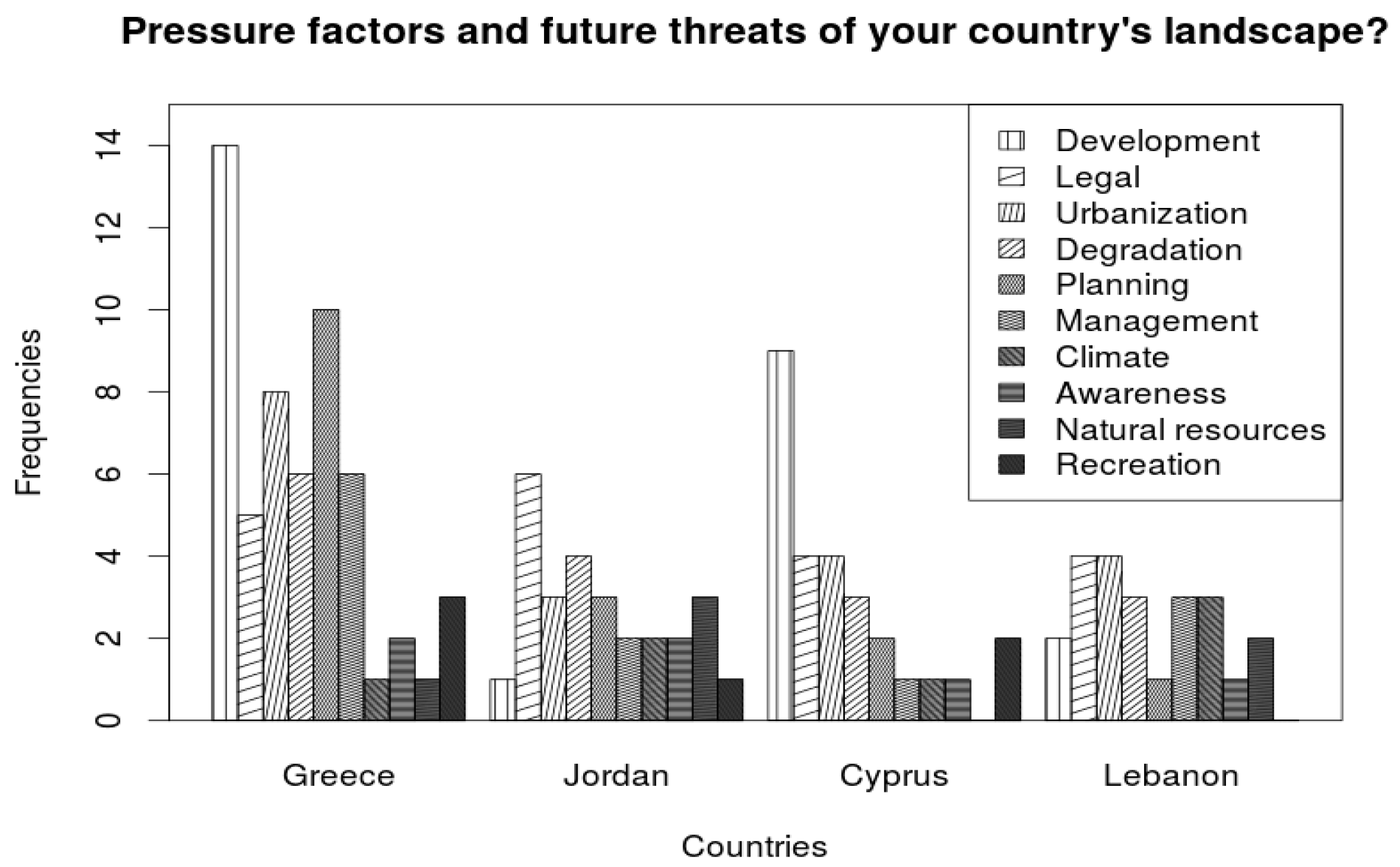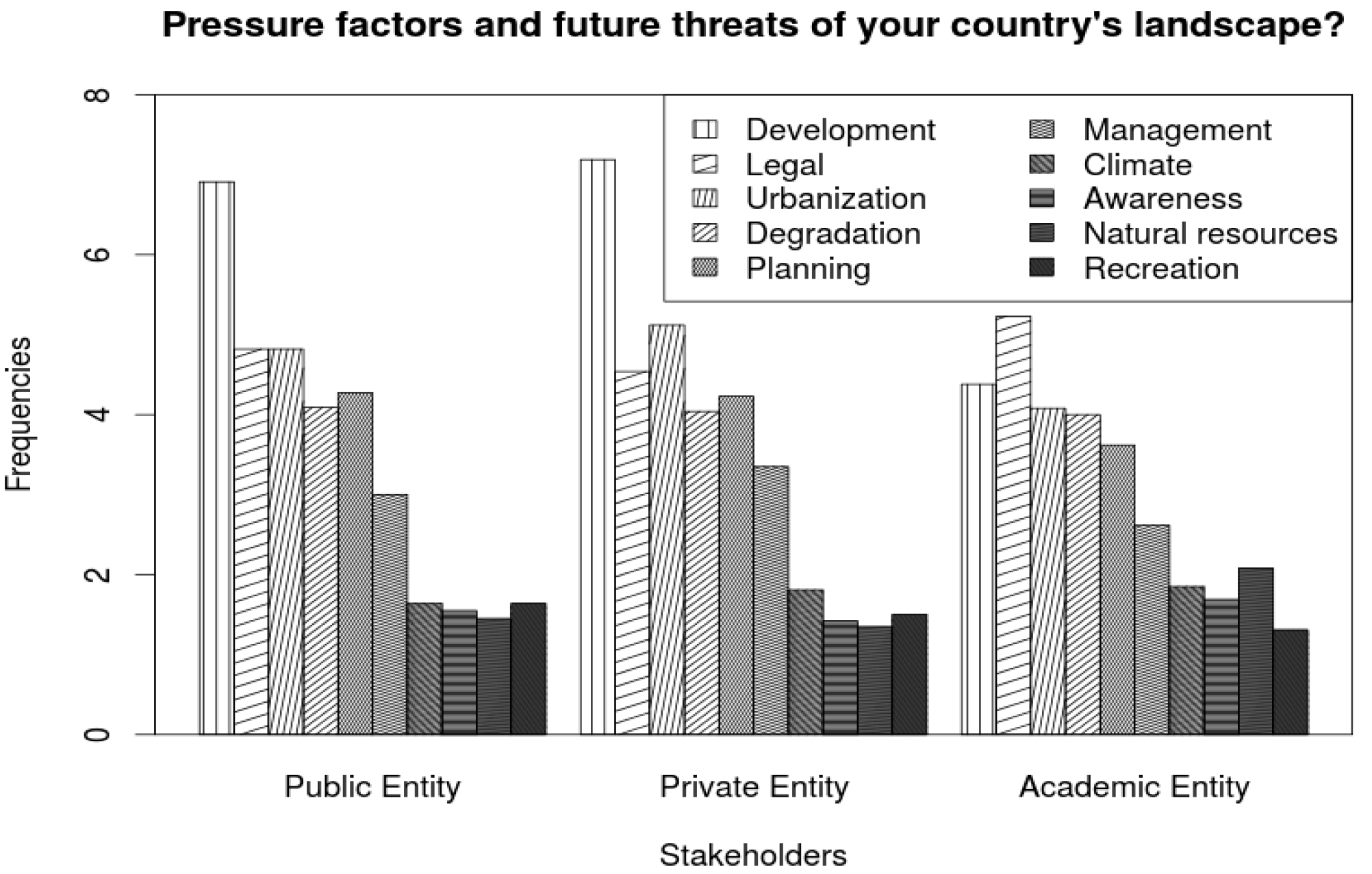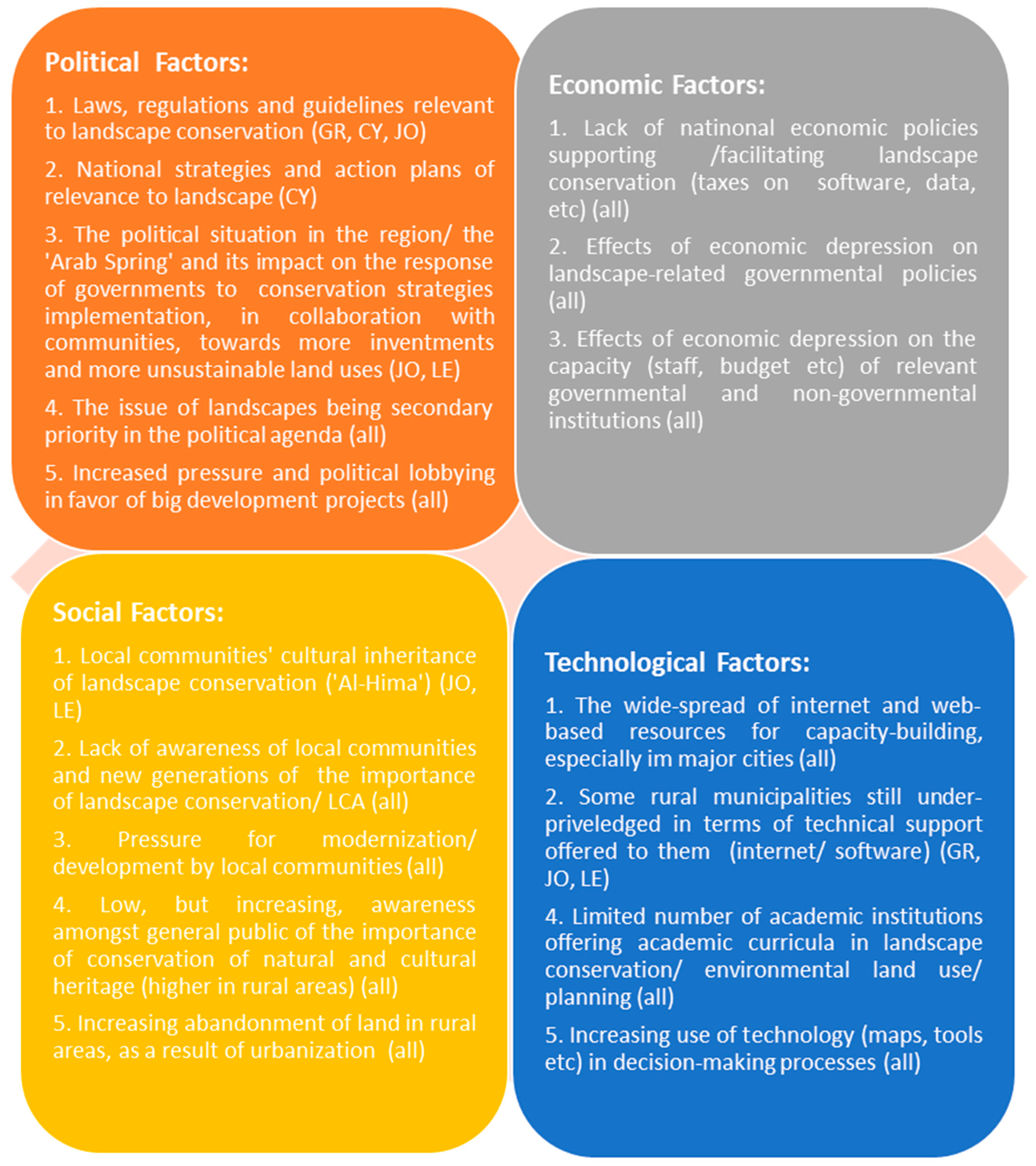1. Introduction and Context of the Study
Having been established as a basic good in the western world, landscape has infiltrated as a concept, a construct and an area of spatial analysis and intervention, elsewhere, in various cultural realms and non-western worlds. The propinquity of the Middle East to Europe and the longstanding interchange between Arab-speaking and Greek-speaking peoples and ways of life and thought has inadvertently influenced landscape notions, values and practices.
With the aid of a stakeholder survey, this paper sets out to assess precisely those commonalities and differences between these two worlds, as regards the landscape concept and management/planning, as the western notions of landscape increasingly take hold also in this part of the world. For this purpose, the paper presents and critically discusses high-level landscape stakeholders’ knowledge, perceptions and understandings of landscape-related issues and problems, in the Eastern Mediterranean, through a purposive comparative research survey in four countries (Cyprus, Greece, Jordan and Lebanon). The study, thus, begins to demonstrate the deeply relational character of the constitution of people’s understanding of and interrelating with the landscape on a broader physical and cultural geographical basis.
The European Landscape Convention [
1] has been widely and rightly acknowledged—at least in Europe—as our most useful and comprehensive tool in setting out the (Western) principles for landscape conceptualization, valuation, planning, use and management. The ELC’s successful negotiation of the (Western) landscape, generally speaking, has inadvertently further entrenched the hegemony of the Western concept and cultural construct of Landscape, displacing or marginalizing local and vernacular landscape notions and terms, around the world. Despite growing acknowledgment of such processes [
2,
3,
4], a great deal of these indigenous, organic ideas and uses of landscape-related terms still goes unnoticed and unaccounted for [
5]. Arguing for situated, contextualized landscape ideas, within their geographical, environmental, cultural and political framework and context, we uphold the most widely-acknowledged premises of landscape definition. These premises rest on the symbiotic relationship of humans with their physical surroundings that is the physical/natural and human/cultural interconnections and interactions, co-existing and co-evolving through time (relational and holistic nature of Landscape). The absence of an Arabic word for ‘landscape,’ for instance, as this paper upholds, is most likely to be due to cultural differences between a Middle-Eastern conception of ‘landscape’ and a Western one. Moreover, the case of the Greek-speaking world appears to be especially complex, due to variable and multiple historical and geographical influences imbued on the processes of formulation of a landscape concept/notion/conscience—as concerns both the actual condition of the Greek landscape and its references and representations—as compared to other (western or northern) such European experiences.
This study was undertaken within the context of an ENPI-MED EU-funded research project (MEDSCAPES
www.enpi-medscapes.org). At the outset of this larger project, a questionnaire survey of high-level landscape stakeholders was undertaken in the four partner countries (Greece, Cyprus, Lebanon, Jordan), aiming at, among other things, unveiling high-level landscape-related stakeholder perceptions and understandings of landscape-related issues, threats and potential, in their countries. For this purpose, after a brief theoretical investigation of the Arab and Greek ‘landscape’ concepts, the article proceeds to the analysis and discussion of its survey findings, with the aid of empirical data and hermeneutical tools.
2. The Western Idea of Landscape
Landscape, a Western—and specifically European—idea, evolved over time, shaping and reflecting the evolution of the European landscape itself [
6,
7]. One of the oldest and most succinct definitions of landscape in the Western world, «a portion of land which the eye can comprehend at a glance» [
8], places great significance to landscape as a visible expression of the humanized environment perceived mainly through sensory and particularly visual, as well as cognitive processes. The visual landscape dimension refers to landscape form—or else, structure—and its ‘objective,’ tangible entity—to distinguish it from its intangible, perceptual and symbolic dimensions, also addressed in the ELC.
Furthermore, landscapes are created by human action and experience inscribed in place through time, enhancing and upholding human livelihoods. Thus, our ways of conceiving the tangible landscape (or landscape dimensions) may broadly be summarized as (a) visual/perceptive and (b) performative/experiential (interactive or relational nature of landscape). In reality, since both of the latter dimensions involve human senses and processes of cognition, they interweave in complex and multi-relational ways of landscape conceptualization, intricately relating the subject (observer, user or visitor) with the object of perception, intervention or pleasure (landscape) [
9,
10,
11,
12]. We may, thus, talk about multiple ‘landscape spatialities,’ the term Cosgrove employs in his discussion of the succession of landscape types in European land use and spatial design history [
13]. Accordingly, landscape in the Western world has not been simply conceived as a piece of land (territory) or its appearance (view, prospect or scenery) [
12]. It has also been defined in terms of “a nexus of community, justice, nature and environmental equity, a contested territory…” [
7], raising issues of shared values, belonging and identity [
14], while bearing the imprint of power and control of its dominant governing or elite classes [
15].
To sum up, landscape is not just the concept of the environment, as modified by humans [
16]; according to the ELC, it also encompasses an intangible, (inter)subjective perspective, people’s perception of it [
17]. Further, it is a real, contingent, embodied, reflexive and unfolding entity. In recent geographical discourse, newly-emerging more-than-representational and enacted landscape geographies highlight the relational constitution of the landscape, signaling a return to its more organic, bottom-up experiential nature (the humanistic tradition). Rather than landscape beheld, what is advocated in these new post-phenomenological landscape geographies is landscape inhabited, engaged with and processed [
18]. Thus, contemporary geographic thought, reflecting broader scientific trends, moves beyond naturalistic views of landscapes as neutral, external backdrops to human activities and culturalistic views of landscapes as cognitive/symbolic orderings of space and advocates an enacted or ‘dwelling perspective’ of landscape constitution [
19].
The Western way of looking at a landscape from a geographically fixed point (a ‘view point’ offering a ‘perfect view’), historically laden with specific aesthetic and geometrical principles, is not universal. The ideas encapsulated in the single word ‘landscape’ may, in other cultural systems, be communicated with the aid of a variety of other terms or meanings, while, at the same time, these other cultures may employ landscape notions and meanings absent from the Western term ‘landscape.’ Well-documented cases, where Western notions of landscape were transposed in other cultural systems, indicate a differential historical evolution, as regards the adoption of such notions, often accompanied by linguistic losses or by processes of linguistic assimilation or acculturation, usually leading to the impoverishment of indigenous alternative landscape notions and practices [
5,
20]. For instance, the Western concept of landscape, always implying some sort of geographical delimitations, differs from South Asian and Chinese concepts that include, among others, undetermined entities without visible borders [
5], territories, or people’s adaptation to specific (natural) local environments [
21]. Similarly, Bruns and van den Brink discuss the inherent absence of the ‘landscape’ concept in the languages of the larger Near East, including Farsi and Turkish. In Turkey, for example, the Western term ‘Peyzaj’ was introduced in the 1920s and evolved to replace indigenous landscape-related terms of Arabic origin. In the process, however, its use gradually encapsulated local conceptions of ‘garden’ and ‘land,’ long-standing societal priorities for a society that eventually ‘owned’ the Western term, in a way adjusting it to its own cultural system [
5].
3. Landscape in the Middle East—The Arab Concept
There is no equivalent word to the English term “landscape”, in the Arabic language. In our discussion of the ways that landscape notions have been conceptualized and used in the Middle East and specifically in Jordan and Lebanon, we will rely on the outstanding groundwork laid out by Jala Makhzoumi, an influential landscape researcher and scholar, in this area of scientific inquiry. Makhzoumi recounts that available translations are generally restricted and outdated, as they essentially adopt the 18th-century English, scenic meaning. The Arabic translation of “landscape”, then, has been variously offered as “natural scenery” [
20], “land scenery” (Baalbaki & Baalbaki 1997 and Nasr & Khatib 1985, both in the work of Makhzoumi [
20]) and “view of the countryside” [
20]. In Arabic culture, however, landscape is not simply a distant viewing experience: “[Landscape] is appreciated bit by bit, through movement in space and time and an engagement of all senses” [
20] (p. 222), [
22]. In place of the seeming absence of a corresponding Arabic term, an array of terms has been traditionally used by Middle Eastern peoples, such as hada’ik (gardens), fadha’at kharijia (outdoor spaces) and bi’a (environment), connoting one or more meanings of landscape [
20] (p. 223). For example, according to the same author, the word “jenna” in Arabic, is used for paradise and it is also a word used for garden; it is once a physical place and a conceptual space, a state of peace and contentment.
Thus, alleged “shortcomings of the Arabic translations can be attributed in part to the complexity of the English word, which makes it impossible to combine the different meanings into a single translation. However, the main shortcoming is due to the difficulties inherent in transferring a complex concept, such as ‘landscape’, from one socio-cultural context to another… intentionally or inadvertently [superimposing] ideas and conceptions… alien to the context of the Middle East. An extreme case in point is Orientalism, a European invention that served as a way of coming to terms with the Orient” [
20] (p. 218). Such a reading of the Middle Eastern landscape was used not only to dominate a place and culture [
23] but also, as argued by Said, to displace “Oriental history as a history possessing its own coherence, identity and sense” (1985: 86).
Indeed, given the colonial history of this part of the world, Makhzoumi [
24] argues for a dual understanding, conceptualization and practice as concerns the landscape, geographically distinguished and anchored in the rural-urban dichotomy of the broader region. The uneasiness and tension in the employment of the different terms implying ‘landscape’ presented above are the outcome of the strenuous coexistence of two conceptions of landscape in the Arab Middle East: “The first, a local interpretation of the English word, dates back to colonial and post-colonial rule, in the first half of the twentieth century… borrowed from Western culture with total disregard to the social and environmental context… [as opposed to] another, less recognized conception that is rooted in long-standing perceptions and vernacular valuations that evolved in the Middle East over millennia. Both conceptions struggle to find [their] correct linguistic expression. The borrowed conception searches for a word in Arabic that encompasses the layered meaning associated with the English word… with little success. Neither is there an all-encompassing word in Arabic for the ‘rooted conception’” [
24] (p. 112).
The landscape conceptualization “borrowed” from the Western definition of landscape has taken root in the colonized, westernized part of the Arabic world (mainly the cities but also all territory where Western planning, design and management rules and norms apply, such as parks, lawns, open spaces, etc.), whereas the “rooted” landscape conceptualization still reigns in environments where “traditional” (but highly dynamic) pre-colonial ways of life persist (mainly the rural world) [
24]. The former landscape conceptualization privileges the more distant, visual/perspectival and aesthetic ‘way of seeing’ the world [
25], which predominate in Western ways of viewing the landscape (as illustrated in the ELC landscape definition), whereas the more organic latter conceptualization of landscape privileges the embodied, reflexive, integrative and instrumental ways of living in and experiencing/relating with it, with all the senses. The former originates in a view from above, or better an oblique birds-eye-view opening up the landscape to its viewer [
26], whereas the latter stems from a view from within.
As described above, the Middle Eastern concept of “landscape”, on the contrary, allows for “an experiential appreciation of one’s surroundings, bit by bit, through movement in space and time, as well as through engagement of all the senses”. As such, it cannot be perceived in one “glance”, nor can it be appreciated through the Westerner’s distant gaze.
Supporting Makhzoumi’s arguments, we base our study design and analysis on the fact that the ‘traditional’ reciprocal relationship between society and space and its concomitant landscape interpretations were severed, after years of colonial domination and recent integration into global systems, as socio-economic and political changes in the contemporary Middle East transformed culture and landscape alike [
20] (p. 219) and alienated the peoples of the colonized territories from their own places. Twentieth-century population increase is changing the rich and extremely heterogeneous physical regional landscape [
20] (p. 219), by replacing traditional, vernacular patterns, both rural and urban, with homogeneous, contemporary ones [
27]. Furthermore, the struggle against aridity has, over the centuries, influenced socio-political organization and shaped cultural expressions and values, including mythological narratives of the broader region. For instance, the design of urban landscapes and gardens as “earthly paradises” [
28] in Arab-Islamic culture has been guided by the dictates of aridity, also amply expressed in Arab-Islamic art.
In the hostile environment of the Middle East, comfort and security and, by association, beauty, are embodied by landscapes that are human-modified and human-made—the colonial agrarian landscape and urban one respectively, in which nature has been ”tamed”, enclosed and ordered. We contend, that the “outward movement” of perceiving “landscape” as a scene that reaches its end in the horizon, is inevitably “introverted” in the Middle East—as are pictorial landscape representations depicted in Greek Orthodox ecclesiastical art, heavily indebted to Middle-Eastern aesthetic norms and practices. Such spatial and landscape interpretations and representations that privilege the spiritual realm and aim to convey an embodied sense of the divine. Nor are “horizon” or perspective as important landscape features, as they are in Western culture, where they imply human control and supervision (surveillance) of the land. Conclusively, according to Makhzoumi [
21] (p. 222), the aesthetic meaning of “landscape” in the Middle East is fundamentally different—physically, perceptually and symbolically—from the Western scenic, “extrovert” historical and contemporary meaning of the word, also permeating contemporary Greek culture. We turn to the latter, next.
4. Landscape in SE Europe—The Greek World
The contemporary urban societies of post-war Greece and Cyprus adopted Western landscape norms and values, in a top-down approach, as these evolved in Europe since the Renaissance and are eloquently laid out in the ELC [
1]. Although both Greece and Cyprus have signed and ratified the ELC, landscape planning and management is not high on the political agenda of either one of the two countries, as in many other Mediterranean countries [
29] (p. 290). Despite the fact that the term “landscape” is now increasingly or implicitly mentioned in various designated protected areas and policies, in both countries, little effort is to put into managing it in an integrated and sustainable way, according to European-level norms and practices [
30,
31]. This may be due to either low prioritization and to a deficient lay landscape conscience, or to the lack of funds and concrete/concerted approaches to landscape management [
32,
33].
In the case of Greece, although a Landscape Committee was formed in the then Ministry of the Environment, Energy and Climate Change, for the first time in 2010, it barely begun to operate towards the implementation of the ELC, before it became ineffective, due to the country’s plunge into “the crisis”. In Cyprus, the authority responsible for the implementation of the ELC is the Department of Town Planning and Housing of the Ministry of the Interior, whose main scope of operation concerns urban and spatial planning. Recent attempts from Town Planning have resulted in the first landscape typology produced for the whole of the island, with a view to using it as a tool for Territorial Planning; the second part of the project on landscape typology was carried out during the MEDSCAPES project, while—despite a genuine interest from the competent authority—progress is slow in integrating landscape assessment in planning policy and legislation [
31,
34]. A further obstacle, in the case of Cyprus, is that landscape continues to mean different things to different disciplines or stakeholder groups, as demonstrated by Vogiatzakis et al. [
31], or to be narrowly defined mostly in terms of its physical attributes but also highly tinged with identity issues and memories of the island’s occupation and displacement. What follows is a more detailed account of the case of Greece; the case of Cyprus resembles the one of Greece, although Cyprus is one step ahead of Greece in terms of ELC implementation—at least as far national-level landscape mapping and Landscape Character Assessment are concerned.
A first but especially revealing view of the Greek landscape, as concerns its symbolic and representational properties and perspectives, emerges through landscape painting at the time of the formation of the new modern nation-state of Greece, after its war of independence in the 19th century [
35] (p. 128). If landscape is a “way of seeing” closely connected to the development in Europe of modern urban, commercial life, then landscape representations in art are renditions in some form of images of the ideological construction of the newly-emergent European nation-states [
6]. Analysis of 19th century Greek landscape painting by Western artists exposes the construction and depiction of the contemporary Greek landscape as a context of human life and experience in accordance with romantic ideals. At the basis of the emergent Greek (and Cypriot, for that matter) cultural identity were two ideals: (a) classicism; and (b) orientalism [
36], expressing contemporary Western views and ideals of the modern Greek state and identity [
37,
38].
In the 20th century, Greek landscape painting gained only partial and gradual emancipation from the influences of foreign schools, through the development of various indigenous forms of expression [
39]. According to Terkenli [
35], however, the landscape ideal and form of representation most influential upon the Greek psyche and most characteristic of the Greek cultural realm remained the two-dimensional, apparently flat but actually inverted, perspective of Greek Orthodox art. The human figure tends to dominate in ecclesiastical iconography, rather than the landscape per se. This inverted and introspected perspective pulls the viewer into the painting, as mentioned in the previous section, “placing” the viewer at the center of the work of art and thus exerting a great power of suggestion over him or her. The creation of the Modern Greek state signaled not only the importing of foreign painting but also all manner of relevant spatial intervention to the Greek landscape (‘top-down’ western influences), as also happened in Cyprus. Nonetheless, Greek Orthodox art, surviving and flourishing amidst the deeply religious populace under Islamic domination, seems to have imprinted its highly influential worldview on the Greek mind and psyche (“bottom-up” concept and construct), providing an ideal and a way of relating to the world still pervasive in Greek life and art [
35].
Although any sort of spatial conscience generally attributed to a cultural system tends to find its roots in the history of a modern nation-state, caution must be exercised in generalizing and totalizing as regards whole cultures or social systems. Before the post-war era of rapid Greek urbanization, Greek people of rural, mountain, or island pre-industrialized communities tended to live under conditions tightly interwoven and in harmony with their particular environments and landscapes [
32,
40], as was the case throughout pre-industrial Mediterranean Europe [
34,
41]. These relationships were inevitably upset or significantly altered, not through colonization but through occupation.
Under Ottoman occupation and cultural stagnation from the mid-15th to the early or mid-19th century, Greece never went through any of the stages of landscape planning and management and a development of landscape conscience that most modern Northern and Western European cultural landscapes had gone through by the 17th century—notions that accompanied the development of the latter landscapes up to our times [
6,
42]. Rather, Greece adopted from the West aspects of modernity in certain realms of life a posteriori, by implanting and overlaying them on to pre-existing cultural particularities and local ways of life. Despite the fact that the word “topio” (signifying landscape in the Modern Greek language) translates into a miniaturization of place, it nonetheless carries all the predominantly visual, aestheticized/scenic and distanced connotations of the Western landscape concept [
13].
This landscape conceptualization has predominated in post-war rapidly-urbanizing Greece, gradually gaining a stronghold in the Greek society, in lieu of a series of environment-, locality- and place-related terms, which used to be employed by pre-industrial, “traditional”-though, certainly, not static-Greek societies in reference to the landscape. The “new”, naturalized as the norm, replaced the “old”. The urbanites and the children of the first and subsequent generations of rural migrants into the big Greek cities never developed such an organic, engaged, “rooted” sense of landscape in the first place. As in the case of the Middle East (see previous section), dissociation from the rural local cultures left behind, during colonial or occupational restructuring, also “undermined the ecological and cultural continuity between the city and the surrounding region, reorienting the city to the West” [
24] (p. 116), to an externally imposed culture. In this way, the city was isolated from its rural hinterland, bearing an enormous landscape diversity, characteristic of the Greek (and Cypriot) territory. It may, of course, be argued [
43] that, with the advent of the 21st century and conditions of affluence before the onset of “the crisis”, Greek landscape conscience has started to re-emerge through the urbanites’ nostalgia for the countryside and the “re-discovery” of landscape through domestic tourism. However, it may be too early to assess such trends, which have taken various new guises and forms, under the current grave socio-economic impacts of ‘the crisis,’ in the Greek-speaking part of the world.
6. Research Findings and Analysis
Next, we present the results of this research survey, after processing the answers in SPSS and R statistical language, at both country and stakeholder levels. The stakeholder levels employed in this analysis were three: public entities, private entities and academic entities, reflecting the type of entity (Institution/Organization) represented by our interviewees.
Question 1. “Is the concept of Landscape officially acknowledged by your Institution/Organization?”
The aim of this question was to identify the official utilization of the concept of Landscape by the Institution or Organization participating in the study, through their surveyed representative. As may be seen in
Figure 1, answers were generally divided more or less equally between “yes” and “no”, with the exception of Greek representatives who mostly responded positively-namely that their Organizations or Institutions officially acknowledged the landscape concept. However, Cyprus respondents seemed to have the best knowledge of such official acknowledgment by their Institutions/Organizations, followed by Greek respondents. The representatives least in-the-know, as concerns this question, were those of Lebanon (with most “don’t know” answers offered), rendering the Lebanese sample’s responses overall rather tentative and more unreliable, as compared with those of representatives from other countries.
Figure 2 shows the absolute frequency of answers to the same question, by stakeholder type (public entity, private entity, or academic entity). In all questions regarding landscape acknowledgment and management in our study, analysis of our findings by stakeholder type indicate a very similar distribution of responses (“yes”-“no”-“don’t know”) among the three types of stakeholders: a rather regular pattern of tentative, yet—as expected—mostly positive responses. This fact of this recurrent accordance in the distribution of answers by stakeholder type strengthens the value of our findings, as concerns the actual situation vis-à-vis landscape stewardship (acknowledgment and management) in the four countries.
Question 2. “Has your Institution/Organization ever been involved in the management, planning, recording or protection of Landscape?”
The aim of question 2 was to establish the ways of involvement of the surveyed Institutions/Organizations in any types of activities regarding the Landscape, i.e., management, planning or protection at the landscape level. The answers are of particular interest. As can be seen in the following
Figure 3, all interviewees from Cyprus belong to an Institution or Organization, which has been involved in landscape-related activities, as opposed to Jordan interviewees, who indicated the lowest involvement in such tasks by their Organization/Institution (almost equal positive and negative answers). Although, obviously, the purposive selection of our interviewee sample may have affected our findings, all of our interviewees seemed to be knowledgeable (no “don’t know” answers) in this regard, a positive outcome strengthening the rest of our findings. The general indication was that for all countries, besides Cyprus, there is still a ways to go, as far as landscape acknowledgment and management are concerned.
Figure 4 depicts interviewees’ answers to the same question, by stakeholder type. Here, as for
Figure 2 (and Figure 6, further down), our data analysis by stakeholder type indicates a very similar distribution of responses (“yes”-“no”-“don’t know”) among the three types of stakeholders, with a predominance again of positive answers but also illustrating accordance in their opinions, thus further strengthening the rest of our results.
Question 3. “To what degree do you consider your country’s existing legal and policy framework adequate for the management of your region’s/country’s Landscape?”
This question aimed at identifying the extent of legal/policy coverage of landscape management, by country. The results, presented in
Figure 5, show that, according to the opinions of our interviewees, there is low or very low legal and policy coverage for landscape management. Thus, in all surveyed countries, the dissatisfaction with the legal/policy framework on landscape is obvious and strong, except for Cyprus, where the opinions of our interviewees seem to be divided. Cyprus was the only country were high satisfaction was quoted. In both Middle-Eastern countries, stakeholders rated their country’s landscape legal/policy framework as very low or non-existent. Greece presents an intermediate case, where the highest degree of intermediate satisfaction among countries was reported but still remains one of the most dissatisfied countries with the issue under investigation.
In
Figure 6, our data analysis by stakeholder type produced the same type of response distribution as in the previous two questions (Graphs 2 and 4) and therefore adheres to the same description and interpretation as that offered for these latter two graphs, above.
Question 4. “What do you consider to be the pressure factors and future threats to your country’s landscape?”
The aim of question 4 was to identify pressure drivers and future threats on the landscape, at the country level. As indicated by our findings (
Figure 7), individuals from Greece and Cyprus stated that, generally speaking, “development” first (and very secondarily “recreation”) were by far the most important pressure factors for the Greek and Cypriot landscapes, as opposed to the other two case studies (Lebanon and Jordan). Representatives of all case studies quoted “legal/policy/regulation” issues, “urbanization” and “degradation” as significant pressure factors impinging on their countries’ landscapes. “Planning” and “management” problems were especially quoted as problems and pressure factors by the Greek respondents, more so than by any other. All of the rest of threats and pressures were quoted to a lesser, though variable, degree by all four country representatives. It is very interesting to note that “the climate” seemed to be more of an issue for the Middle-Eastern countries, as reported by their representatives, than by the European countries of our sample.
Finally,
Figure 8 illustrates the same data, analyzed by stakeholder type. Here, again, as for the previous questions, similar findings in terms of landscape threats and pressures were offered by all three types of stakeholders. The main exception here were the academics, who did not rate “development” as highly as private and public Institution/Organization stakeholders did, as a threat to the landscape—they rather quoted “natural resource” preservation as an area of future landscape threat or concern, together with relevant “legal and policy” issues. The latter finding may simply have to do with the academics’ general orientation to and preoccupation with their own more specific scientific interests. Otherwise, there was, once again, general accordance between the answers of the three stakeholder types.
7. Discussion of Findings
What emerges from this exploratory study of the state of landscape management (including planning and policy-making) in the four countries, through the opinions and knowledge of high-level stakeholders, is a clear but rather disappointing, image of the state of affairs. All four countries are lacking in the acknowledgement and fulfillment of their landscape needs, although they all carry and employ some concept of landscape, which lies at the basis of all relevant practices, plans and policies. It comes as no surprise that Greece and Cyprus are ahead of the Middle-Eastern countries (questions 1 and 2), at least due to the fact that Greece and Cyprus have signed and ratified the ELC but seem to be slow in implementing it. Jordan may be seen to be one step ahead of Lebanon (question 1), if only because the Jordanian organization/institution representatives interviewed seemed to carry a more concerted and informed understanding and knowledge of their countries’ landscape predicament—the landscape concept being, at least nominally, acknowledged in the Jordanian legislation.
More specifically, as regards the official acknowledgement of the landscape concept by the sampled organizations/institutions and their involvement with tasks at the landscape level, on the basis of these findings, we may deduce that the landscape concept seems to have gained a stronghold in most of these countries’ relevant institutions and organizations, yet not to as high a degree as desirable (because of the high number of negative responses) but generally speaking, rather somewhat more so than not (questions 1 and 2). In one only case, did a Jordanian stakeholder provide the western landscape definition, as follows, “all the visible features of an area of land, often considered in terms of their aesthetic appeal.” In all other cases, in both Jordan and Lebanon, such definitions revolved around resource conservation, revealing the difference between the more instrumental local conceptions of landscape, versus formal western ones. Cyprus, generally speaking, emerges as the country most advanced in this respect. Not only did the Cypriot respondents seem to have the clearest understanding of the situation but they also reported the highest levels of involvement by their organizations/institutions in landscape-related activities (i.e., landscape recording/mapping, planning, protection, management etc.).
As regards the degree to which these respondents considered their countries’ existing legal and policy frameworks adequate for the management of their country’s landscapes, again, the Cypriot ones overwhelming answered positively. They, thus, put themselves at the lead concerning progress achieved vis-à-vis the implementation of the ELC and as compared to the rest of the countries, with Greece being next in line (question 3). Generally, however, the dissatisfaction with the legal/policy framework on landscape in all four countries was reported to be high, with the exception of Cyprus, where the overall picture was ambivalent, followed by Greece—where dissatisfaction with the existing legal/policy landscape framework was high. This finding may due to the widespread realization of Greece’s lagging position vis-à-vis ELC implementation—as opposed to what is expected and as compared to other European country cases [
44,
45]. The latter finding is further upheld and strengthened by findings with regard to the final question (question 4), whereby Greek representatives, most of all other country representatives, referred to ‘planning’ and ‘management’ issues as landscape problems and pressure factors. This finding may be due to the need for proper planning and stewardship of the Greek landscape, being felt more urgently in Greece, which is especially lagging in these respects (and also, as compared to Cyprus) towards the implementation of the ELC and exacerbated as a consequence of the current socioeconomic crisis.
Coming, finally, to the problems and pressures threatening the landscape (question 4), the key problem faced in all four countries, as in the wider Eastern Mediterranean region, is the rapid pace of change currently taking place in their landscapes, jeopardizing their ecological diversity, visual quality, cultural patterns and functional integrity. Specifically, in our interviewees’ words, landscape problems and threats abound at all levels of landscape planning, protection and management (from the national to the local) and in all sectors of the economy, society and space, related to the landscape (rural production, urbanization, tourism, etc.) (
Table 1). There are strong pressures stemming from urbanization and tourism development in certain “hotspots” and, at the same time, rural abandonment undermines the traditional activities that helped shape the rural landscape, in the first place (
Figure 9). Certain recurring problems seemed to run the gamut of all our country cases: “legal/policy/regulation” issues, “urbanization” and “degradation”. This finding points not only to legal/political deficiencies in catching up with the rest of the Western world vis-à-vis their landscape stewardship but also reflects the repercussions of rampant urbanization and long-standing environmental degradation, in this part of the world: “the imprint of urbanization on the landscape of the Middle East threatens ecological stability, undermines long-term environmental sustainability and erodes the regional landscape character” [
20] (p. 225). Overall, however, there was some differentiation between the European vs. the Middle Eastern countries of our study (though one may not generalize these findings to the whole Middle Eastern region, see [
46,
47]), in this regard, as Cyprus and Greece indicated “development” and, to a lesser degree, “recreation” as significant landscape problems and pressures, in contrast to Jordan and Lebanon. Finally, as expected, the latter two countries—already extremely water-conscious—indicated a more heightened concern about “the climate”, which is probably due to serious water-shortage risks implied in scenarios of climate change and global warming.
It is interesting to put these findings in the context of the conclusions of the MedScapes Project, illustrating, through both quantitative and qualitative data, the very same trends, as reported above (
http://www.enpi-medscapes.org/images/Deliverable/MEDSCAPES REPORT ON STAKEHOLDERS NEEDS KNOWLEDGE.pdf). Generally speaking, as far as the implementation of landscape mapping and character assessment methods, Cyprus and Greece, again, seemed to be one step ahead of Jordan and Lebanon. As emerges from all of the interviewees’ responses, central dimensions of the concept such as the visual/aesthetic perspective of the landscape, as well as the constitution of landscape itself through people’s perception (ELC), are totally absent. Specifically, in answers to our open-ended questions, the definition and utilization of the landscape concept by Middle Eastern organizations and institutions was “conservation of natural resources,” “conservation of the area around the archeological sites… in the World Heritage Sites,” “management of the urban green” etc., while, only at the academic level, was there some acknowledgment of the “flexibility of the landscape definition, depending on the [course] instructor… i.e., ‘Landscape Design’ is a project-based course, it focuses on site-analysis… [landscape architecture rules]… as well as the development of landscape design in Far Eastern, European and Islamic cultures.” Nonetheless, there was a detailed recording and addressing of the basic landscape elements (natural and cultural), pointing not only to the inclusivity of the landscape term itself in Greek and in Arabic—as acknowledged by those surveyed—but also to the rich linguistic traditions of the four countries, as regards the landscape concept, which is not easily translatable from one language to the other. Whereas, as already discussed earlier in this article, there exists one single term signifying the landscape in Greek (‘topio’), this is not the case in Arabic, where, in order to connote this concept, either certain aspects of the landscape or more descriptive terms tend to be employed. The problem of translation, thus, is linked to the problem of landscape conceptualization, among the four countries and the two languages (Greek and Arabic).
External risk factors include political unrest and economic instability (Lebanon, Greece), difficulty of obtaining certain spatial data (Lebanon, Greece and Jordan), possible lack of state/authority willingness to consider a landscape character framework for decision making (in Lebanon and Jordan, not adhering to the European Landscape Convention). Currently, there seem to be emerging increasing trends towards holistic and sustainable conservation and management of natural and cultural resources and initiatives towards integrated land use planning. All of the latter are greatly affecting or encompassing landscape issues and causes, despite various drawbacks and threats to landscape planning, management and protection, generally speaking: (a) lack of internationally-corresponding terms and concepts as concerns the landscape; (b) lack of awareness especially among public stakeholders of the importance of landscape protection, planning and management and of a lay landscape conscience; (c) different or insufficient policies and legal frameworks regarding the landscape or landscape aspects/resources, despite common pressures on it; (d) political and planning pressures that go against the sustainable management of the landscape and natural/cultural resources, in favor of big development projects; (e) the complexity of landscape issues making its incorporation in policy-making, research agendas and higher educational programs difficult and (f) lack of accessible resources rendering the issue of landscape not a priority in the agenda of policy-makers and various other relevant stakeholders.
Conclusively, our survey findings reveal great commonalities among the Greek- and the Arabic-speaking countries of our study, as concerns the pressures currently exerted and the threats admonished vis-à-vis the landscape (
Figure 1), although equally significant differences (both within and between countries) persist in the ways these pressures and problems are dealt with. As expressed in the interviewees’ responses, these trends are a striking evidence of great stakeholder needs and concerns, as regards all aspects of the landscape, in all four countries—including the use of methods and techniques for its assessment, mapping, planning and management. External pressures obviously vary from NE MED sub region to sub region. On the one hand, the volatile political situation and ‘the Arab spring’ have brought about re-prioritizations of political and social agendas but, on the other, the effects of economic depression and threats of environmental/climate change have equally applied to the whole SE Mediterranean region: on governmental policy-making, on institutional capacity and on land use and resource planning and management. People’s connection to the land and to landscape, however, is uneven, both in terms of time-place and in terms of cultural context. In the Greek world, landscape conscience is presently deficient or often non-existent, whereas in the Arab world (areas under study) such a conscience has traditionally been tied to the sustainable management of common lands (i.e., ‘Al Hima’—
1). The findings of this stakeholder survey more generally speaking, point to the need, not only for a technical approach to landscape assessment and mapping but also to the need to train and sensitize the societies in all four countries, in landscape matters, landscape interventions, as well as to raise their awareness and mobilization vis-à-vis their landscapes. Comments received through open-ended questions, in Jordan, exposed this concern as follows: “The public lack knowledge and the authorities are neglecting the future needs of the population,” “the concept of landscape is vague to the general public here… need to raise awareness of the definition and importance of the natural and cultural heritage.”
8. Concluding Remarks
The past twenty years or so have witnessed a turn more in favor of a landscape approach also in land stewardship and management. It is increasingly advocated that a whole-landscape approach provides the most appropriate spatial framework for protection and sustainable management of natural and cultural heritage; even nature conservation and management are now widely considered to be effective only when carried out at the landscape level [
14,
46,
47,
48,
49,
50].
Such a development stems not only from obligations incurred by the adoption of the ELC but also by practical necessities, prompting the development of landscape tools, methods, typologies and mapping at a variety of scales, from local to Europe-wide [
44,
45,
51]. However, as the ‘People’s Convention,’ according to one of its creators, Michael Dower, underscores, its emphasis is first on people, people’s perceptions and on socio-cultural contexts, requiring further scientific investigation.
In this light, this study explored human ways of interrelating with landscape, at the interface between ‘East’ and ‘West,’ that is, between the Arab and the Greek worlds, in the Eastern Mediterranean region. This task was undertaken in a region in turmoil, given continuing risks from development pressures and current ‘crises,’ high diversity at the landscape level and the fact that the diverse and complex cultural and natural Mediterranean heritage is almost always inextricably entwined with and affected by human activities (and indeed often dependent upon them) [
40], [
52] (p. 299), [
53]. The integrity of Mediterranean landscapes is currently threatened by common problems: pollution, overgrazing and tourism development. Lack of public awareness, political commitment or intersectoral co-operation also hinder the protection of natural heritage. Despite the common nature and origin of these problems, the actions and approaches employed so far seem to vary widely between—and even within—these worlds and countries of the region.
In conclusion, our survey findings reflect the uneasiness and confusion of a forced co-existence, in the area under study, of Western with autochthonous landscape concepts and ways of appropriation. On the one hand, then, in our interviewees’ responses, we encounter the territorial/legal/commodified or visual/scenic/distantiating means of human-landscape interrelating, while, on the other hand, we discern the Arabic and (‘traditional’) Greek experiential ways of associating with and assessing the world, through all human senses and common everyday practices. The understanding and stewardship of any ‘landscape,’ such as the ones under study here, in the Eastern Mediterranean region, reflect what different societies and individuals perceive and imbue with value in their surroundings and how such perceptions and understandings of space may relate to common needs and interests, as well as collective identity formation. Therefore, such understanding and stewardship ought to take shape on their own terms, within their cultural context, irrespective of Western norms, i.e., embracing the formalistic and visual/aesthetic Western ideas of landscape, in order to uphold the great wealth of the world’s concepts of landscape [
20] (p. 218), [
21].
While currently the scope of new meanings to the term landscape is still expanding, in some parts of the world, elsewhere part of the variety of existing terms expressing a number of different aesthetic and environmental/territorial concepts is gradually being lost, in a continuous flow of global mono-cultural colonization. However, no party’s perceptions, understandings and associations with space and landscape ought to be left out in landscape protection, planning and management [
1,
44,
45]. In sum, we ought to be making use of constructivist notions of landscape [
54,
55], in recovering not only the “substantive meaning” [
7] of the term ‘landscape’ but also the great wealth of the word’s landscape-related concepts, at large. For that purpose, we ought to be combining and linking such concepts as deriving from all perspectives: (a) (disciplinary and trans-disciplinary) scientific/academic; (b) (local and international) professional and (c) the civil society at large, including the public’s and all relevant stakeholders’ viewpoints into ‘landscape’ discourse, cause and practice.
